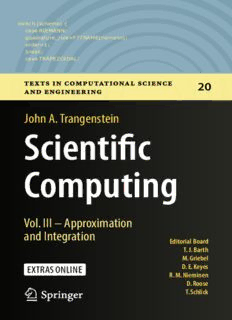Table Of Contentswitch (scheme) {
case RIEMANN:
quadrature_rule=F77NAME(riemann);
order=1;
break;
case TRAPEZOIDAL:
20
John A. Trangenstein
Scientifi c
Computing
Vol. III – Approximation
and Integration
Editorial Board
T. J.Barth
M.Griebel
D.E.Keyes
R.M.Nieminen
D.Roose
T.Schlick
Texts in Computational
20
Science and Engineering
Editors
TimothyJ. Barth
MichaelGriebel
DavidE. Keyes
RistoM. Nieminen
DirkRoose
TamarSchlick
Moreinformationaboutthisseriesathttp://www.springer.com/series/5151
John A. Trangenstein
Scientific
Computing
Vol. III – Approximation
and Integration
123
JohnA.Trangenstein
ProfessorEmeritusofMathematics
DepartmentofMathematics
DukeUniversity
Durham
NorthCarolina,USA
Additionalmaterialtothisbookcanbedownloadedfromhttp://extras.springer.com.
ISSN1611-0994 ISSN2197-179X (electronic)
TextsinComputationalScienceandEngineering
ISBN978-3-319-69109-1 ISBN978-3-319-69110-7 (eBook)
https://doi.org/10.1007/978-3-319-69110-7
LibraryofCongressControlNumber:2018932366
MathematicsSubjectClassification(2010):34,41,65
©SpringerInternationalPublishingAG,partofSpringerNature2017
Thisworkissubjecttocopyright.AllrightsarereservedbythePublisher,whetherthewholeorpartof
thematerialisconcerned,specificallytherightsoftranslation,reprinting,reuseofillustrations,recitation,
broadcasting,reproductiononmicrofilmsorinanyotherphysicalway,andtransmissionorinformation
storageandretrieval,electronicadaptation,computersoftware,orbysimilarordissimilarmethodology
nowknownorhereafterdeveloped.
Theuseofgeneraldescriptivenames,registerednames,trademarks,servicemarks,etc.inthispublication
doesnotimply,evenintheabsenceofaspecificstatement,thatsuchnamesareexemptfromtherelevant
protectivelawsandregulationsandthereforefreeforgeneraluse.
Thepublisher,theauthorsandtheeditorsaresafetoassumethattheadviceandinformationinthisbook
arebelievedtobetrueandaccurateatthedateofpublication.Neitherthepublishernortheauthorsor
theeditorsgiveawarranty,expressorimplied,withrespecttothematerialcontainedhereinorforany
errorsoromissionsthatmayhavebeenmade.Thepublisherremainsneutralwithregardtojurisdictional
claimsinpublishedmapsandinstitutionalaffiliations.
Printedonacid-freepaper
ThisSpringerimprintispublishedbytheregisteredcompanySpringerInternationalPublishingAGpart
ofSpringerNature.
Theregisteredcompanyaddressis:Gewerbestrasse11,6330Cham,Switzerland
To mygrandsonsJackand Luke
Preface
This is the third volume in a three-volume book about scientific computing. The
primary goal in these volumes is to present many of the important computational
topics and algorithms used in applications such as engineering and physics,
together with the theory needed to understand their proper operation. However, a
secondarygoalin thedesign ofthis bookisto allowreadersto experimentwith a
numberof interactiveprogramswithin the book,so thatreaderscan improvetheir
understandingoftheproblemsandalgorithms.Thisinteractivityisavailableinthe
HTMLformofthebook,throughJavaScriptprograms.
Theintendedaudienceforthisbookareupperlevelundergraduatestudentsand
beginninggraduatestudents.Duetotheself-containedandcomprehensivetreatment
of the topics, this book should also serve as a useful reference for practicing
numericalscientists. Instructors could use this book for multisemester courses on
numericalmethods.Theycouldalsouseindividualchaptersforspecializedcourses
suchasnumericallinearalgebra,constrainedoptimization,ornumericalsolutionof
ordinary differential equations. In order to read all volumes of this book, readers
shouldhaveabasicunderstandingofbothlinearalgebraandmultivariablecalculus.
However, for this volume it will suffice to be familiar with linear algebra and
single variable calculus. Some of the basic ideas for both of these prerequisites
are reviewed in this text, but at a level that would be very hard to follow without
prior familiarity with those topics. Some experience with computer programming
wouldalsobehelpful,butnotessential.Studentsshouldunderstandthepurposeof
acomputerprogram,androughlyhowitoperatesoncomputermemorytogenerate
output.
Manyofthe computerprogrammingexampleswilldescribetheuse ofa Linux
operating system. This is the only publicly available option in our mathematics
department, and it is freely available to all. Students who are using proprietary
operating systems, such as Microsoft and Apple systems, will need to replace
statementsspecifictoLinuxwiththecorrespondingstatementsthatareappropriate
totheirenvironment.
This book also references a large number of programs available in several
programming languages, such as C, CCC, Fortran and JavaScript, as well as
vii
viii Preface
MATLABmodules.Theseprogramsshouldprovideexamplesthatcantrainreaders
to developtheir own programs,fromexistingsoftware wheneverpossibleor from
scratchwhenevernecessary.
Chaptersbeginwithanoverviewoftopicsandgoals,followedbyrecommended
books and relevant software. Some chapters also contain a case study, in which
the techniques of the chapter are used to solve an important scientific computing
problemindepth.
Chapters typically begin with a summary of topics and goals, followed by
recommendedbooksandrelevantsoftware.Manychaptersalsocontainacasestudy,
in which the techniques of the chapter are used to solve an important scientific
computingproblemindepth.
Chapter 1 discusses interpolation and approximation. These topics are often
introducedinintroductorycalculus,butneedmuchgreaterelaborationforscientific
computing.Thetechniquesinthischapterwillbefundamentaltothedevelopment
ofnumericalmethodsintheremainingchaptersofthisvolume.
Chapter2presentsnumericalmethodsfordifferentiationandintegration.Numer-
ical integrationcan employ importantideasfrom probability,or usefultechniques
frompolynomialapproximation,togetherwiththeskillsusedtoovercomerounding
errors.Thechapterendswithadiscussionofmultidimensionalintegrationmethods,
which are not commonly discussed in scientific computing texts. This chapter
dependsonmaterialinChap.1.
Chapter 3 discusses the numerical solution of initial value problems in ordi-
nary differential equations. The mathematical analysis of these problems is fairly
straightforward and generally easy for readers to understand. Fortunately, some
verysophisticatedsoftwareisavailableforjustthispurposeandrepresentsa level
of achievement that should be the goal of software developers working in other
problemareas.ThischapterdependsonmaterialinChaps.1and2.
ThefinalChap.4examinesordinarydifferentialequationswithspecifiedbound-
ary values. The mathematical analysis of these problems is more difficult and is
often approached either by eigenfunction expansions (a topic that builds on the
discussion in Chap.1 of Volume II) or by functional analysis (a topic that few
studentsintypicalscientificcomputingclasseshavestudied).Thischapterdepends
onmaterialinthethreeprecedingchapters.
Insummary,thisvolumecoversmathematicalandnumericalanalysis,algorithm
selection, and software development. The goal is to prepare readers to build
programsfor solving important problems in their chosen discipline. Furthermore,
theyshoulddevelopenoughmathematicalsophisticationtoknowthelimitationsof
the pieces of their algorithmand to recognizewhen numericalfeaturesare due to
programmingbugsratherthanthecorrectresponseoftheirproblem.
Iamindebtedtomanyteachersandcolleagueswhohaveshapedmyprofessional
experience.IthankJimDouglasJr.forintroducingmetonumericalanalysisasan
undergrad. (Indeed, I could also thank a class in category theory for motivating
me to look for an alternative field of mathematical study.) John Dennis, James
Bunch,andJorgeMoréallprovidedafirmfoundationformytraininginnumerical
analysis, while Todd Dupont, Jim Bramble, and Al Schatz gave me important
Preface ix
training in finite element analysis for my PhD thesis. But I did not really learn to
program until I met Bill Gragg, who also emphasized the importance of classical
analysis in the development of fundamental algorithms. I also learned from my
students,particularlyRandyLeVeque,whowasinthefirstnumericalanalysisclass
Ievertaught.Finally,IwanttothankBillAllardformanyconversationsaboutthe
deficienciesinnumericalanalysistexts.Ihopethatthisbookmovesthefielda bit
inthedirectionthatBillenvisions.
Mostofall,Iwanttothankmyfamilyfortheirloveandsupport.
Durham,NC,USA JohnA.Trangenstein
July7,2017
Contents
1 InterpolationandApproximation.......................................... 1
1.1 Overview ................................................................ 1
1.2 PolynomialInterpolation ............................................... 5
1.2.1 Well-Posedness................................................ 5
1.2.2 NewtonInterpolation.......................................... 8
1.2.3 LagrangeInterpolation........................................ 18
1.2.4 HermiteInterpolation ......................................... 22
1.2.5 RungePhenomenon........................................... 24
1.2.6 ChebyshevInterpolationPoints............................... 25
1.2.7 BernsteinPolynomials ........................................ 28
1.3 MultidimensionalInterpolation ........................................ 29
1.3.1 Multi-Indices .................................................. 30
1.3.2 Simplices ...................................................... 34
1.3.3 Blocks.......................................................... 39
1.3.4 ErrorEstimate ................................................. 43
1.4 RationalPolynomials................................................... 47
1.4.1 PadéApproximation .......................................... 47
1.4.2 ContinuedFractions........................................... 54
1.4.3 RationalInterpolation......................................... 57
1.5 QuadricSurfaces........................................................ 57
1.6 Splines................................................................... 59
1.6.1 Continuous..................................................... 60
1.6.2 ContinuouslyDifferentiable .................................. 63
1.6.3 TwiceContinuouslyDifferentiable........................... 69
1.6.4 CaseStudy:Electro-Cardiology.............................. 76
1.6.5 CardinalB-Splines ............................................ 76
1.6.6 ErrorEstimate ................................................. 84
1.6.7 TensionSplines................................................ 86
1.6.8 ParametricCurves............................................. 89
xi

